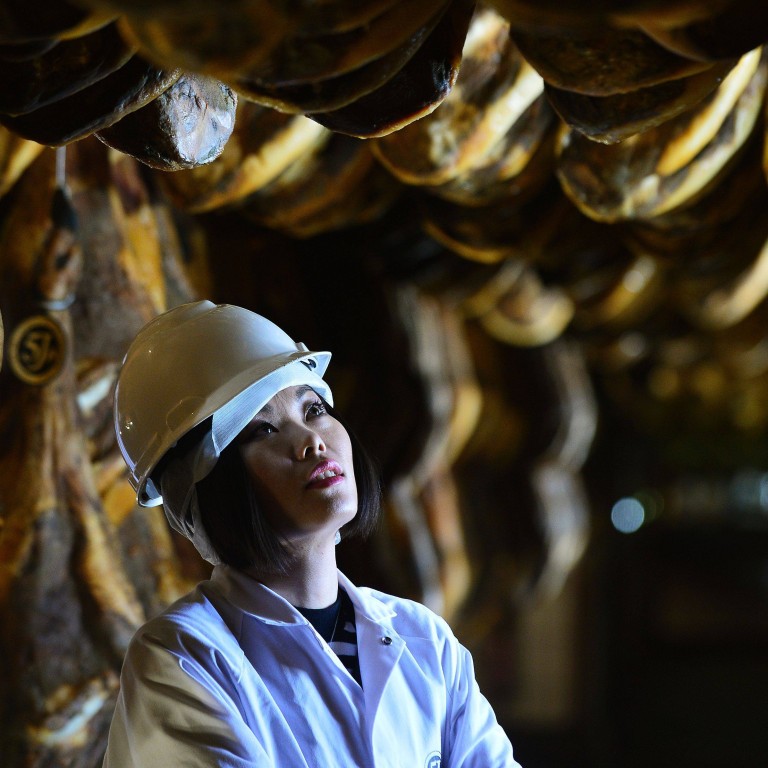
China’s middle class is developing a taste for high-end meat, sending imports surging
- China’s growing middle class and greater consumer awareness about the origins of food have driven up demand for higher quality meat
- In the first 10 months of 2021, sales of Spanish cured hams and shoulders grew more than 32.96 per cent in value to be worth 17.35 million euros (US$19.6 million)
China’s appetite for high-end foreign food is growing with imports of expensive pork cuts and other meats from Europe increasing last year and more multinational food companies investing in the world’s largest consumer market.
In the first 10 months of 2021, sales of Spanish cured hams and shoulders – including Iberian and Serrano varieties – grew more than 32.96 per cent in value to be worth €17.35 million (US$19.6 million), and increased 80.8 per cent by volume, reaching 1,059.72 tonnes, according to data from the Spanish Foreign Trade Institute.
Overall, ham imports from Spain saw significant growth in China last year, with unboned ham and other cold cuts increasing in value by 62 per cent from a year earlier, while bone-in ham grew by 125 per cent, according to Chinese customs data.
Imports of ham and cold cuts from Italy also increased by 75 per cent over 2020.
On Tuesday, the Interprofessional Association of the Iberian Pig said China was the market with the “greatest potential” and it forecast sales to increase by 60 per cent over the next three years.
Ruben Martinez, from Beijing-based Eibens Consulting, which specialises in European food exports to China, said mutton imports had increased in value almost 40 per cent in the first 11 months of the year, while frozen beef grew 20 per cent.
“The growth is even higher for fresh or chilled beef imports,” he said. “These are the highest-end meat products in China, and although in absolute terms they represent only 5 per cent of total imports, the growth is over 40 per cent, reflecting a growing appetite for these premium products.”
They are not only looking at the quality and taste of the meat, but also its origin, animal welfare and food security
With demand for high quality imported meat products increasing, the potential in China is very promising, said Steven Xu, chief representative for China at VanDrie Group, a Dutch veal producer and exporter.
“As Chinese consumers grow more conscious about the nutrients in beef and other meat products, they are more and more selective about what they buy and what they eat,” Xu said.
Martinez said food perceived as healthier receives more attention in China.
“Organic products have high potential in China, especially for some categories like dairy, infant formula and cereal products,” he said. “Organic imported wine is another category on the rise.
“However, the main barrier for imported organic products is the lack of recognition for foreign certifications and the complex process of certification in China.”
China imported more than US$1.08 trillion worth of food in 2020, and US$1.01 trillion worth in the first three quarters of last year, up 29.8 per cent from a year earlier, according to a report on imported food published during the China International Import Expo last November.
The market for quality goods, including imported meat and produce, has expanded rapidly as China’s middle class population has grown.
Thailand switches to chicken, as others in Asia halt Canadian beef imports
Encouraged by Chinese consumers’ increasingly refined food taste, the company said in November it will add four to five stores every year for the next few years. It aims to have a total of 40-45 stores in operation or under construction by the end of this year.
China is the largest consumer market in the world, with retail sales worth 44.08 trillion yuan (US$7 trillion) last year, according to the National Bureau of Statistics. Its middle class population reached 400 million in 2021, accounting for nearly 30 per cent of the total population.
“More and more multinational corporations in the food industry from the United States and Europe are raising their stakes in China, as they believe in the massive market potential here,” said Tony Wang, from strategy consulting firm Tractus Asia Limited.



